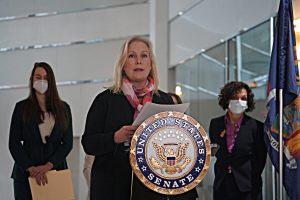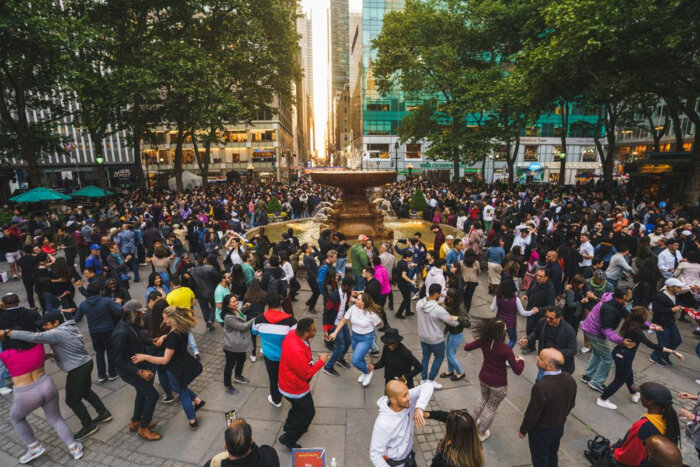The odds of becoming a human trafficking victim at the hands of a lover or family are far greater than conspiracy theories and Hollywood depictions of abductions lead many to believe.
That’s the word from experts seeking to dispel widely held misconceptions about the hidden-in-plain-sight underworld of human trafficking that continues to plague Long Island, despite authorities stepping up efforts to combat this modern form of slavery in which victims are mentally shackled through fraud, force, and coercion — and more often than not by common criminals, not jet-setting millionaires like Jeffrey Epstein.
“On Long Island there’s a lot of things happening right in front of us that we never even recognize,” Jeffrey Reynolds, Ph.D., president and CEO of the Hempstead-based nonprofit Family and Children’s Association (FCA), said while hosting an Oct. 12 event at the Nassau County Police Department Center for Training & Intelligence. “It is vitally important to distinguish between the many common misconceptions about and the realities of human trafficking. We can all become better advocates for ourselves and our community.”
Local authorities have made 58 human trafficking arrests — 24 in Nassau, 34 in Suffolk — between 2008 and 2021, according to the New York State Division of Criminal Justice Services. Most were sex trafficking cases, but one was labor trafficking. Those stats don’t include federal cases. Long Island is among the top 20 jurisdictions nationwide impacted by human trafficking in the nation, according to the U.S. Department of Justice.
Former Suffolk County District Attorney Tim Sini, who prioritized human trafficking investigations during his tenure, said that some ruthless traffickers thought little of their victims, others suspects didn’t understand that what they were doing was considered exploitation.
“[A former drug dealer] realized he could make a lot more money in human trafficking, in sex trafficking, than in drugs, because with drugs you would have to sell the drugs and then you would have to buy more drugs, but with people, with girls, you could keep selling the same product,” said Sini, who’s now partner at the law firm Nixon Peabody LLP. Others couldn’t comprehend that coercing women into having sex for money was trafficking and “viewed themselves as having a positive relationship with the victim — that if it weren’t for them the victim would be much worse.”
Moderating the Oct. 12 discussion was Keith Scott, the grants director for FCA who was previously director of education for The Safe Center LI, a Bethpage-based nonprofit organization that provides support for victims of trafficking, domestic and sex crimes. He refuted a number of commonly held trafficking myths.
“All of the misinformation out there is really doing a disservice to our community,” he said, noting a debunked viral hoax about supposed traffickers tying zip ties to cars to mark their victims for abduction. “When many of us hear about trafficking, many of us think about kidnapping, but it’s much more malicious. It’s kidnapping, but not in the physical way. It’s mental manipulation, it’s coercion.”
The experts cited the incident of a sharp-eyed police officer being suspicious of an older man with a disheveled young woman in a car that triggered a trafficking probe, as an example of progress that has been seen in an increasing number of people being educated on the warning signs. But there is still work to be done.
Among the signs to watch for in children are truancy, inexplicably carrying large amounts of cash, having hotel keys, using a fake ID, lying about their age, suffering unexplained injuries, and making sexually explicit posts on social media.
Vulnerable populations such as children, immigrants, and people suffering from the disease of addiction are often the preferred target of traffickers. While children are most likely to be victimized by family, organized human trafficking syndicates tend to prey on people desperate to emigrate — with confiscated passports, salary, and housing leveraged to manipulate labor trafficking victims coerced into working jobs that often were based on fraudulent prospects. In the case of addicts, traffickers control victims with a drug debt, making victims — often women, but sometimes men — have sex for money and turn over their earnings to pay off the drugs they used. And with the ongoing opioid epidemic worse than ever, the potential pool of victims is deeper than ever.
“When you think about trafficking, you think of bondage and chains,” Scott said. “For those addicted, it’s a chemical tether.”
Related Story: Long Island’s Human Trafficking Crisis Thrives in Shadows
Related Story: Inside the Hidden World of Sex Trafficking on L.I.
Related Story: Human Trafficking on Long Island


























